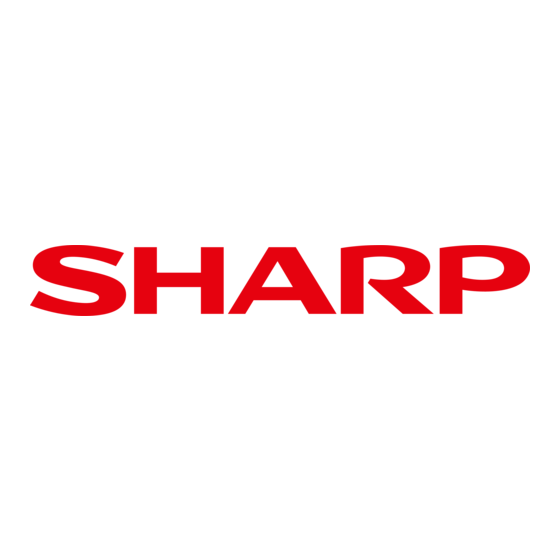

Sharp Notevision PG-M10S Basic Information & Preparations
Digital multimedia projector
Hide thumbs
Also See for Notevision PG-M10S:
- Operation manual (49 pages) ,
- Operation manual (49 pages)
Table of Contents
Advertisement
Quick Links
Usage Guidelines
95˚F
(+35˚C)
41˚F
(+5˚C)
For SHARP Assistance (U.S.A. only)
If you encounter any problems during setup or operation of this projector, first refer to the "Troubleshooting" section on page
35. If this operation manual does not answer your question, please call toll free 1-888-GO-SHARP (1-888-467-4277) for further
assistance. Or, send us an e-mail at lcdsupport@sharplcd.com.
Our World Wide Web address is http://www.sharp-usa.com/.
6
Caution Concerning the Lamp Unit
Potential hazard of glass particles if lamp has ruptured. Please have
Sharp Authorized LCD Projector Dealer or Service Center replace
lamp if rupture occurs.
See "Replacing the Projection Lamp" on page 37.
BQC-PGM10X//1
Cautions Concerning the Setup of the Projector
For minimal servicing and to maintain high image quality, SHARP
recommends that this projector be installed in an area free from
humidity, dust and cigarette smoke. If the projector is used in these
environments, the lens will need to be cleaned more often, and
internal cleaning may become necessary. As long as the projector is
10 X
PG -M
regularly cleaned, use in these environments will not reduce the
overall operation life of the unit. Internal cleaning should only be
performed by a Sharp Authorized LCD Projector Dealer or Service
Center.
Notes on Operation
• The three marks shown on the left are caution labels for parts of
• The cooling fan (exhaust vent), the lamp cage cover and adjacent
• Allow at least 10 cm (3
10 X
PG -M
• If the cooling fan becomes obstructed, a protection device will
10 X
PG -M
the projector that emit intense heat during operation.
areas may be extremely hot during projector operation. To prevent
injury, do not touch these areas until they have sufficiently cooled.
15
/
inches) of space between the cooling
16
fan (exhaust vents) and the nearest wall or obstruction.
automatically turn off the projector lamp. This does not indicate a
malfunction. Remove the projector power cord from the wall outlet
and wait until the projector has sufficiently cooled. Then turn on the
power by plugging the power cord back in. This will return the
projector to the normal operating condition.
Advertisement
Table of Contents

Summarization of Contents
Usage Guidelines
Lamp Unit Safety
Warns of glass particle hazard if lamp ruptures; advises authorized replacement.
Projector Setup Environment
Recommends installation in clean, dry areas to maintain image quality and reduce cleaning needs.
Operation Safety Precautions
Advises caution for hot areas, proper ventilation (10 cm clearance), and fan obstruction auto-off.
Projector Key Features
Compatibility and Image Quality
Supports multiple video standards, delivers sharp, clear images with accurate color reproduction.
Advanced Technology and Design
Utilizes DMD technology for efficiency, offers PC control via remote, and has a compact, portable design.
Supplied Accessories
Remote Control and Batteries
Includes the remote control unit and the required AAA/R03 batteries for operation.
Video and Computer Connection Cables
Provides Video, S-Video, Computer RGB, and audio cables for various inputs.
Power Cords and Carrying Case
Offers region-specific AC power cords, a soft pouch, and a protective carrying bag.
Included Documentation
Contains the main Projector Operation Manual and a Quick Reference Guide.
Remote Control Preparation
Battery Installation Guide
Step-by-step instructions for inserting the two AAA/R03 batteries correctly into the remote.
Remote Control Handling Tips
Advises on care for wet remotes, avoiding extreme environments, and proper battery mixing practices.
Remote Control Operational Range
Details the effective horizontal (50°) and vertical (30°) angles and maximum working distance (4m).
Projector Part Identification
Top and Front Panel Layout
Identifies control panel, buttons, indicators, lens, speaker, and cooling fan on the front.
Bottom Panel Layout
Identifies foot release, lamp cover, rear adjuster, and cooling fan on the projector's bottom surface.
Projector Part Identification
Rear and Side Panel Layout
Identifies remote sensor, Kensington lock, AC socket, and rear adjuster on the rear/side panels.
Terminal Panel Inputs
Details the various input terminals for computer, audio, video, and S-Video connections.
Kensington Security Feature
Explains the Kensington Security Standard connector used for device security.
Remote Control Part Identification
Front View Controls
Labels buttons like MENU, MOUSE, VIDEO, POWER, AUTO SYNC, ENLARGE, and the LED indicator.
Rear View Controls
Labels buttons such as ENTER, L-CLICK, R-CLICK/UNDO on the rear of the remote.
Top View Transmitter
Identifies the remote control signal transmitter located at the top of the remote.
Projector Installation Guidelines
Unit Positioning and Image Size
Explains how distance from the screen affects projected image size, with reference to charts.
Projection Distance and Image Size Charts
Provides detailed tables and diagrams for screen size, projection distance, and image height.
Advanced Installation Setups
Reversed Image Projection
Details methods for rear projection and mirror projection using the menu system.
Mirror Projection Setup
Instructions for positioning a mirror and reversing the image via the projector's menu system.








Need help?
Do you have a question about the Notevision PG-M10S and is the answer not in the manual?
Questions and answers